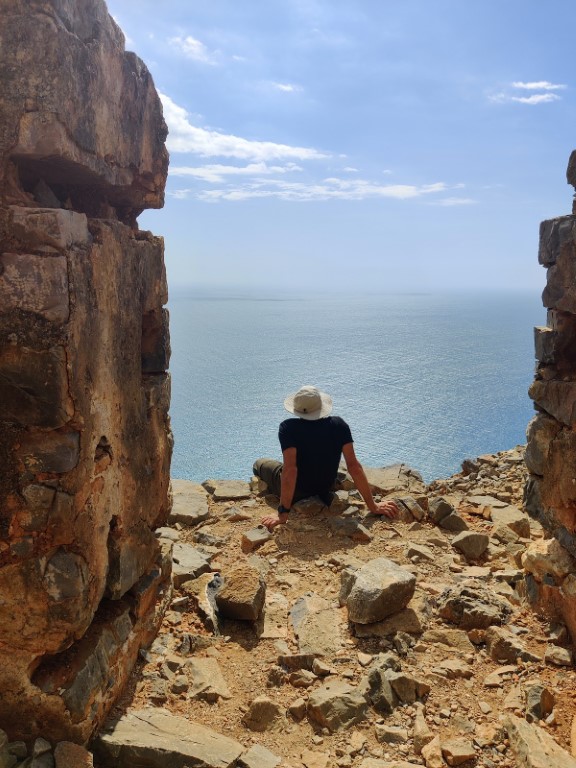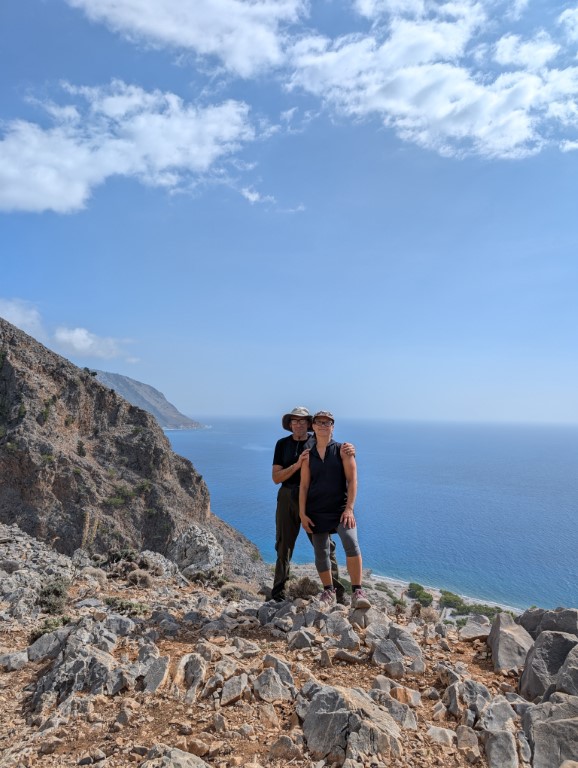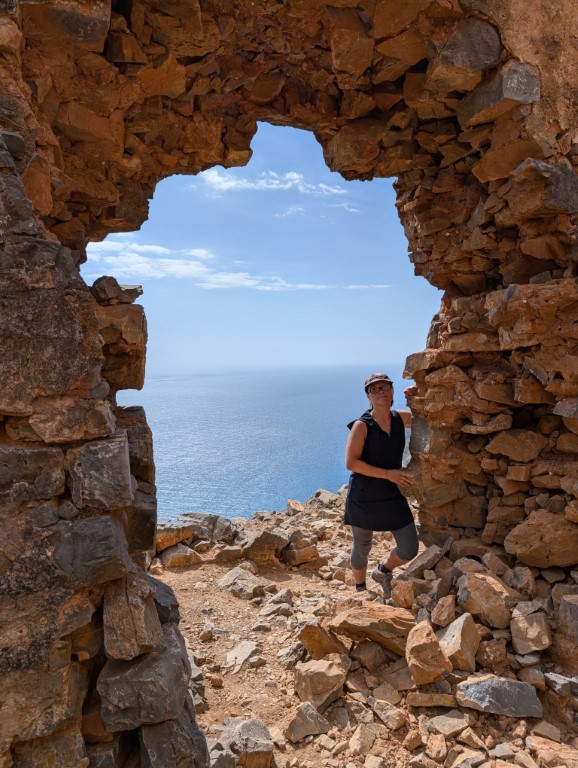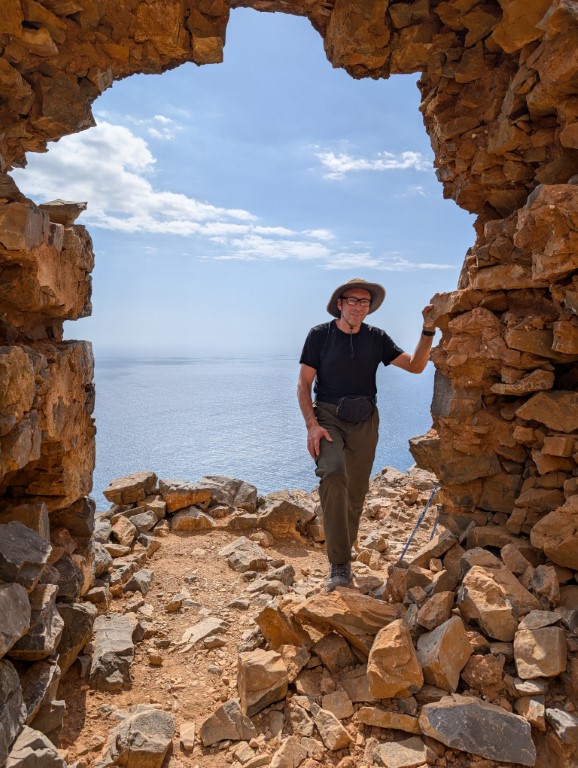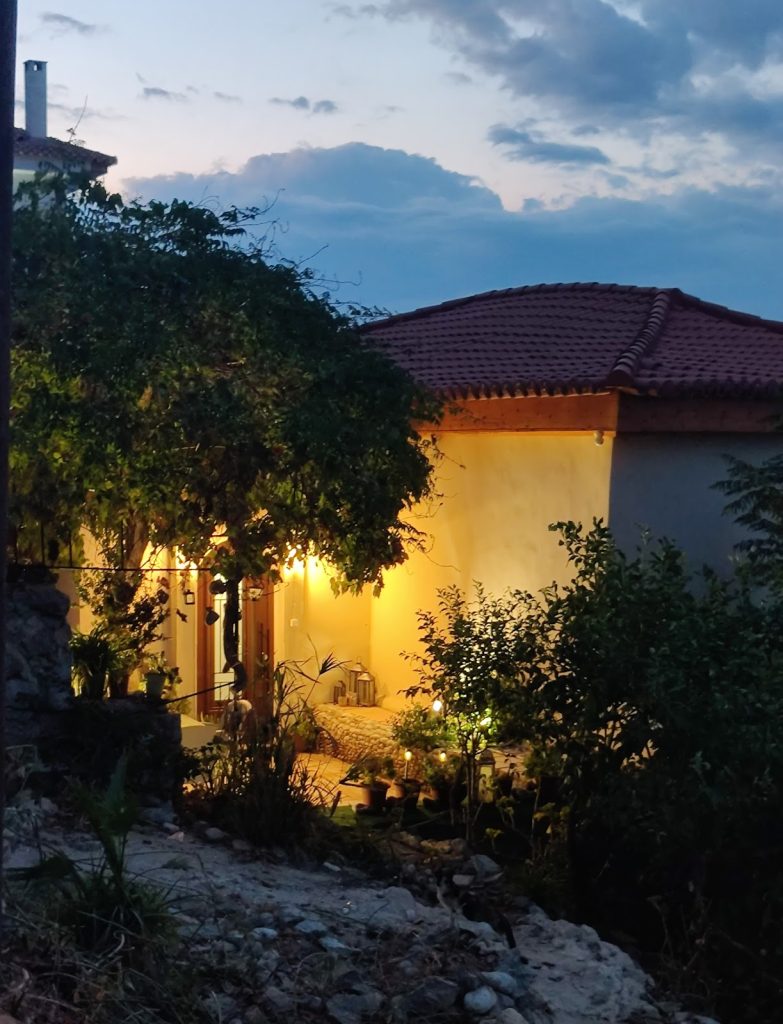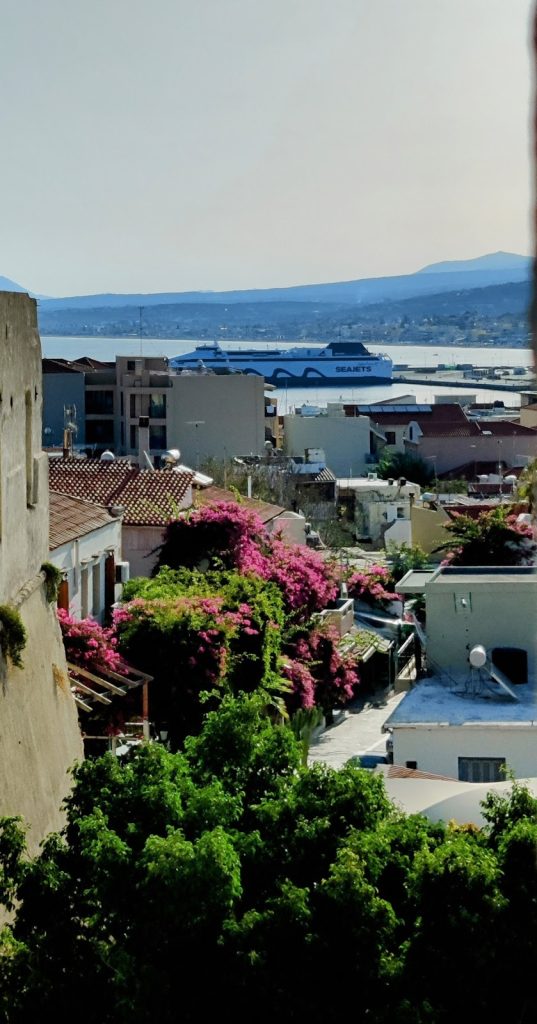October 5
Over a hearty breakfast before checking out of the hotel, we chat with the hostess.
She says:
- My name is Spiridula, which is Greek and starts with 100%. A given name can have both male and female variants. Spyridon would be a man's name.
- My name is Natasha.
- Ah! Natasha! In Greece, it's a diminutive of Anastasia.
To say that I was very surprised is to say nothing.
Spiridula asks where we're going next. Upon learning that we're going to Portaria, she exclaims:
- This is a very beautiful place! I have no doubt that you will like it!
We bid a warm farewell to the talkative Spiridula and continue on our way. Our route leads through the narrow, rocky, and very picturesque Tempi Valley. The road winds along the riverbank, between overhanging cliffs on both sides. Even despite the gloomy weather, it's very beautiful here. A suspension bridge is listed among the interesting places. When we approach it, it turns out to be broken. Here in Greece, this is a common occurrence: something broken, something left unfinished for a long time. Ancient ruins mixed with new ones.
Our goal was to get onto the toll road, but we took the wrong turn and, after making a circle, found ourselves in the same valley. The second time, we didn't miss the mark and successfully reached the archaeological reserve in the town of Dimini. Apparently, it's not often visited. Apparently, not every traveler is interested in seeing what a Neolithic, pre-Hellenistic settlement looked like. This was also evident in the sleepy expression of the ticket collector (and part-time guard), who wasn't expecting an influx of two tourists. After wandering around the excavation site, Denis and I agreed that the settlement's circular architecture most closely resembled Arkaim. The burial, resembling a wide well, was also distinctive. We had already seen something similar in Mycenae.
And off we go again. We're driving through the Thessalian Valley. Cotton fields, orchards, and olive groves flash by outside the windows. Greece is an agricultural country. But beyond the town with the strange name of Volos, the road climbs again, into the mountains. And after countless turns, we find ourselves in Portaria.
This is another mountain village, only more civilized and populous than the previous one. We check into a small, newly renovated hotel with a charming lobby and a brand new room.
In fact, the hotel is at least a hundred years old; it just recently underwent a radical renovation. It's becoming popular these days to preserve the original stonework on the outside while furnishing everything inside with modern interiors.
We have lunch at a busy restaurant across the street and go for a walk around the neighborhood.
The trail first follows the road, then winds between pastures and olive groves, then descends to a small village with many abandoned houses and neglected gardens. Three large dogs joined us on the outskirts. Their presence initially made us a little uneasy, but they were friendly: wagging their tails, smiling, tongues hanging out, and apparently hoping for a treat.
But we had no food with us. Nevertheless, the dogs continued on with us. They turned out to be sociable fellows. When we approached a rocky ravine, it became clear that the trail had been washed away and part of it had collapsed. What should we do? Turn back? The dogs looked at us questioningly: "Where to next?" The map showed that the continuation of the route was somewhere nearby. We descended the scree but couldn't find the trail. Then we climbed back up and found ourselves in a thicket of clawed bushes. Suddenly, a short yelp sounded overhead. Three meters higher up the slope, on a previously unnoticed stone fence, stood one of our familiar dogs, inviting us to come up. "Easy to say 'come up'!" I replied, and climbed up, into the thickest of the thorny brambles. My shin ended up scratched, but the rest of my body remained unharmed. It seems Denisov suffered more scratches.
While we were searching for the trail, evening fell, and it became clear it was best to return home. The dogs walked with us for a while, but at a roadside restaurant they decided to stop, and we said goodbye to our furry companions, grateful for their help in finding our way.
Already on the outskirts of Portaria we suddenly came across some kind of explanatory sign.
It said that it was here, on Mount Pelion, that the centaur Chiron lived, according to mythology. Naturally, we wanted to explore this place.
The centaur, by all appearances, lived a rather ascetic life. The location was a small, shady gorge with a stream flowing between the mountain slopes. According to legend, there was supposed to be a cave, but we didn't find one. All we could do was use our imagination and picture the centaur and his charges—the future heroes.
Meanwhile, deep shadows had settled in the gorge, and it was time to return. By evening, the weather had suddenly cleared, and a stunning yellow sunset spread picturesquely across the sky and the distant mountain range.
We'd already returned to the hotel by then and were enjoying the view from the balcony. I'd cooked something light for dinner.
We sat and drank tea, watching the sunset burn out and fade, as dusk came and lights came on in the houses on the slopes of Pelion.
Later that evening, we decided to take an evening stroll through Portaria. It wasn't a relaxing stroll, because the streets in mountain villages, as we all know, are steep and winding. It's amazing how the locals manage to drive here! And to discourage visitors from parking anywhere, they put up signs saying "Idiotico parking," which means "private parking.".
We laughed for a long time at these inscriptions, because completely different associations arose.
The next morning began with the jubilant ringing of bells from the bell tower opposite.
We'd forgotten it was already Sunday, and Greece is a religious country. At seven in the morning, people are expected to hurry to the morning service. And if you're not in a hurry, they'll broadcast it over the loudspeaker. Since it's happening in the mountains, the echo of the morning service and the following service resounds loudly throughout the surrounding area. The deep-voiced priest continued to preach for so long that we had time to get up, get dressed, wash, eat breakfast, pack, and go for a walk.
We decided to take a final stroll along the old streets of Portaria. From various points in the village, there were excellent views of the sea in the distance, the towns in the valley, and the villages in the mountains.
But it's time to move on. Today, we'll visit hot springs, Thermopylae, and the resort town with the strange name of Kameno Vourlo.
A strange mismatch between geographical names and my understanding haunted me that day. Firstly, Portaria wasn't actually in a port, by the sea, but in the mountains. Secondly, Thermopylae isn't a farm with saws, although the association was firmly ingrained in my mind because it sounded similar. Of course, I knew about the historic Battle of Thermopylae from that same fifth-grade history textbook, but I'd never thought about translating the name. It turns out the name translates as "warm gate," which suggests hot springs.
Incidentally, we didn't find the narrow isthmus between the mountains and the impassable swamp at Thermopylae, where the Persians treacherously attacked the Greeks. Over the millennia, the swamps must have turned into fertile fields. There was, however, a memorial complex there commemorating the historic battle. And the hot springs still exist. We made sure to stop there.
Thirdly, the resort town of Kameno Vourlo on the Aegean Sea has nothing in common with anything made of stone. Well, there are some stone features there, but nothing particularly remarkable: a beach, cafes, restaurants, and hotels.
Denis later found the translation; it means "Burnt Reed." We also remember Kameno Vurlo for the "small" seafood dish at one of the restaurants. The small dish turned out to be so big that we even skipped dinner that evening. What, then, would a large dish look like?
In general, I realized for myself that there is no need to try to get to the truth with the help of home-grown etymology, but it is better to look into more reliable sources of information.
But still, the geographical names here are unusual.
By the way, we spent the day in Leptokarya, but didn't go to Skotina. Well, to the gods!
Go to Greek Trip Homepage.
